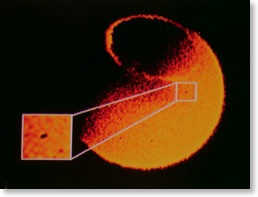Small Comets
(This article has been reproduced from the Center for Scientific Creation. The original article can be found here.)Photographs taken from Earth-orbiting satellites show small, ice-filled comets striking Earth’s upper atmosphere at an average rate of one every three seconds. [See photograph below] Each comet adds 20–40 tons of water to the Earth’s atmosphere. If this influx began when evolutionists say the Earth started to evolve, all our oceans would have come from small comets. Actually, impact rates were undoubtedly greater in the past, because the planets have swept many of these comets from the solar system. Therefore, small comets would have placed much more water on Earth than is here today. Obviously, this did not happen, so oceans look young.
The Dynamic Explorer satellite took this picture in ultraviolet light showing small comets (the dark spots) colliding with Earth’s upper atmosphere. The comets begin to break up 800 miles above the Earth’s surface, then frictional heating vaporizes the pieces and their descent stops at an elevation of about 35 miles. The water vapor, which soon dissipates, blocks ultraviolet light from Earth, producing the dark spots. The northern lights are shown by the halo.
----------
(This article was taken from the book, In the Beginning by Dr. Walt Brown. The book can be purchased from the Center for Scientific Creation. The original article can be found online here. For more information about Dr. Walt Brown, click here).
